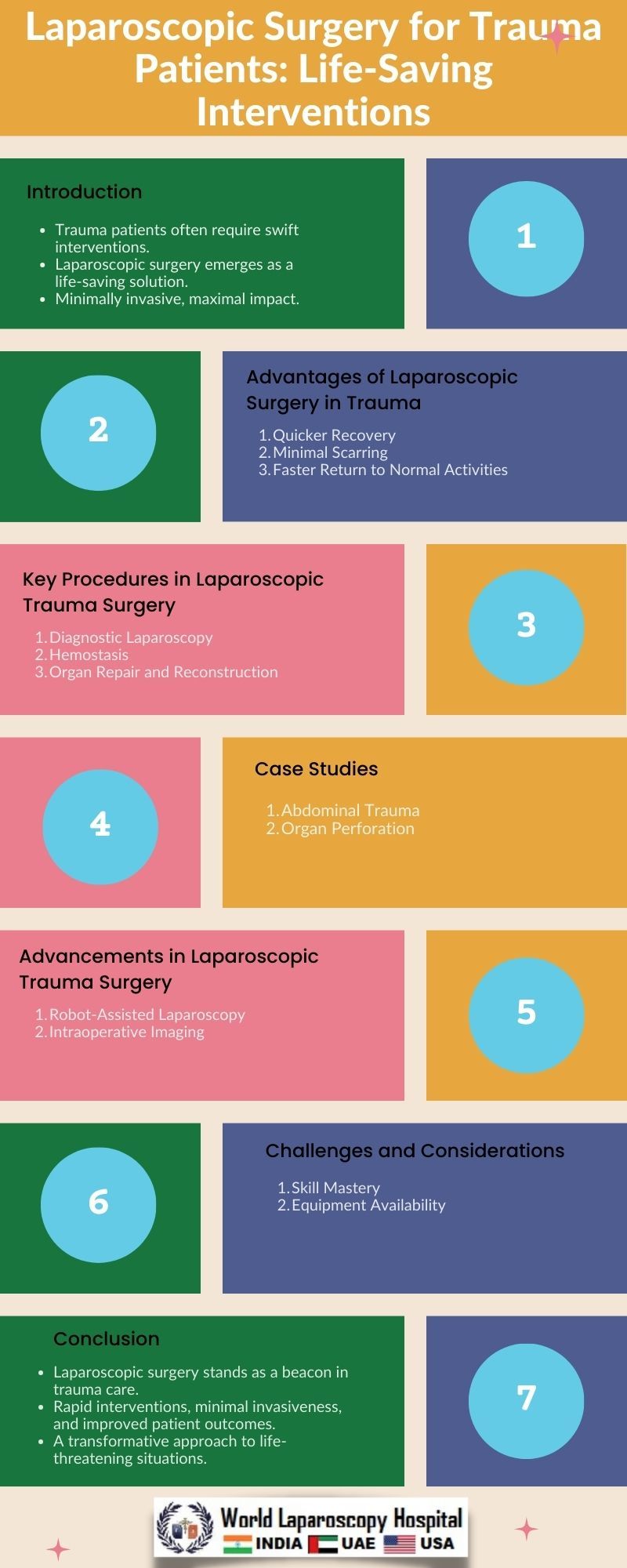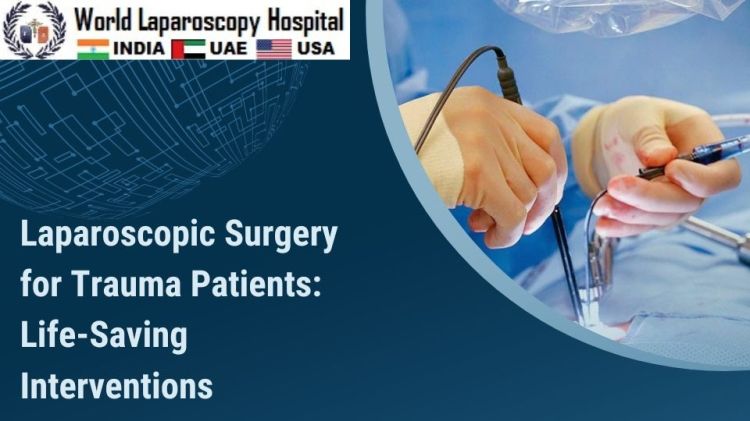Laparoscopic Surgery for Trauma Patients: Life-Saving Interventions
Introduction:
In the realm of emergency medicine, where every moment is critical, laparoscopic surgery has emerged as a revolutionary life-saving intervention for trauma patients. Traditionally, trauma surgeries involved large incisions, extended recovery times, and increased risks of complications. However, the advent of laparoscopic techniques has transformed the landscape, providing a more precise and minimally invasive approach to address internal injuries promptly.

Understanding Laparoscopic Surgery:
Laparoscopic surgery, also known as minimally invasive surgery or keyhole surgery, involves the use of small incisions and specialized instruments equipped with cameras. These instruments are inserted into the body, allowing surgeons to visualize and operate on internal organs without the need for large openings. This technique offers numerous advantages over traditional open surgeries, particularly in the context of trauma cases.
Swift Intervention and Reduced Recovery Time:One of the primary advantages of laparoscopic surgery in trauma cases is the speed with which it can be performed. In emergencies, time is of the essence, and the minimally invasive nature of laparoscopic procedures allows surgeons to intervene swiftly. Small incisions mean less trauma to the surrounding tissues, leading to reduced postoperative pain and faster recovery times for patients.
Precision in Diagnosis and Treatment:The high-resolution cameras used in laparoscopic surgery provide surgeons with a detailed and magnified view of the internal organs. This enhanced visualization facilitates more accurate diagnosis and targeted treatment of injuries. From identifying bleeding vessels to repairing damaged organs, laparoscopic techniques enable surgeons to address trauma-related issues with unprecedented precision.
Lower Risk of Complications:The smaller incisions used in laparoscopic surgery result in decreased blood loss, reduced risk of infection, and a lower likelihood of postoperative complications. This is particularly crucial in trauma cases where patients may already be in a compromised state. The minimization of surgical trauma contributes to overall improved outcomes and a lower risk of systemic complications.
Applications in Trauma Surgery:
Laparoscopic surgery finds diverse applications in trauma cases, ranging from abdominal injuries to thoracic and pelvic trauma. The adaptability of this technique allows surgeons to navigate and address a variety of injuries with different tools and approaches.
Abdominal Trauma:Abdominal injuries often pose significant challenges in trauma surgery. Laparoscopic techniques excel in addressing injuries to organs such as the liver, spleen, and intestines. In cases of internal bleeding, laparoscopic procedures allow for efficient identification and suturing of bleeding vessels, minimizing blood loss and preserving vital organs.
Thoracic Trauma:Penetrating injuries to the chest can cause damage to the lungs, heart, or major blood vessels. Laparoscopic surgery can be employed to access and repair these structures with minimal invasiveness. The use of thoracoscopy, a variant of laparoscopy for the chest, enables surgeons to perform procedures such as lung resections or repair of thoracic injuries with smaller incisions.
Pelvic Trauma:Pelvic fractures and injuries often require intricate surgical interventions. Laparoscopic approaches allow for precise exploration of the pelvic region, addressing fractures and internal injuries. The reduced tissue trauma is especially beneficial in preserving the delicate structures surrounding the pelvis, minimizing the risk of complications and expediting recovery.
Case Studies:
Several case studies highlight the efficacy of laparoscopic surgery in trauma scenarios.
Severe Abdominal TraumaA patient presented with severe abdominal trauma following a motor vehicle accident, with suspected injuries to the liver and spleen. Traditional open surgery posed significant risks due to the extent of the injuries. Laparoscopic exploration revealed a laceration in the liver and a splenic injury. The surgeons were able to precisely suture the liver laceration and control bleeding from the spleen using minimally invasive techniques. The patient experienced a quicker recovery and fewer postoperative complications than would have been expected with an open procedure.
Penetrating Thoracic InjuryA stabbing victim arrived at the emergency room with a penetrating injury to the chest, with potential damage to the lung. Traditional thoracotomy was considered, but the surgical team opted for a thoracoscopic approach. The procedure revealed a small puncture in the lung, which was repaired with sutures. The patient recovered without the need for prolonged chest tube drainage, showcasing the benefits of laparoscopic surgery in thoracic trauma.
Challenges and Considerations:
While laparoscopic surgery offers significant advantages, there are challenges and considerations that surgeons must navigate in trauma cases.
Patient Selection:Not all trauma cases are suitable for laparoscopic interventions. In cases of severe instability or extensive injuries, traditional open surgery may still be the preferred approach. Patient selection is crucial, and surgeons must assess the feasibility of laparoscopic techniques based on the specific circumstances of each case.
Training and Expertise:Laparoscopic surgery requires specialized training and expertise. Surgeons must be proficient in using the equipment and interpreting the visual information provided by the cameras. Training programs and ongoing education are essential to ensure that surgical teams can effectively and safely perform laparoscopic procedures in trauma settings.
Equipment Availability:Laparoscopic surgery relies on specialized instruments and high-quality imaging equipment. Availability and access to these resources may vary, particularly in emergency situations. Hospitals and trauma centers must invest in the necessary infrastructure to support the implementation of laparoscopic techniques in trauma surgery.
Future Directions:
As technology continues to advance, the future of laparoscopic surgery in trauma care looks promising.
Robot-Assisted Laparoscopy:The integration of robotic systems into laparoscopic surgery holds the potential to enhance precision and dexterity. Robot-assisted laparoscopy allows for more complex maneuvers and may further reduce the invasiveness of procedures, opening new possibilities for trauma interventions.
Telemedicine and Remote Assistance:Telemedicine platforms could play a significant role in trauma surgery, especially in resource-limited settings. Surgeons experienced in laparoscopic techniques could provide remote assistance and guidance to less-experienced teams, expanding the reach of minimally invasive interventions in emergency situations.
Conclusion:
Laparoscopic surgery has revolutionized the field of trauma surgery, offering a paradigm shift in the approach to life-threatening injuries. Its benefits, including rapid intervention, enhanced precision, and reduced recovery times, make it a valuable tool in the hands of skilled surgical teams. As technology continues to advance and expertise grows, laparoscopic surgery is poised to play an even more prominent role in saving lives and improving outcomes for trauma patients around the world.
